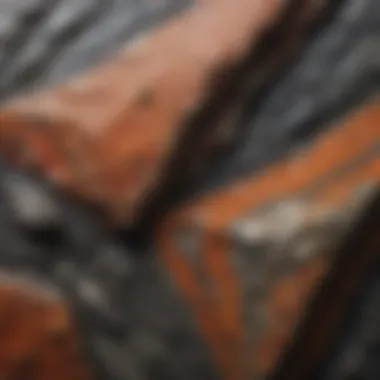Unveiling the Allure and Importance of Granite in the World of Rock Collecting


Rock and Fossil Identification
In the realm of rock collecting, an essential aspect is the identification of various rocks and fossils, each possessing distinct characteristics that set them apart. When it comes to granite, enthusiasts seek to recognize its unique traits that make it so coveted among collectors globally. Granite is a coarse-grained igneous rock with a composition primarily of quartz, feldspar, and mica, giving it its characteristic speckled appearance. Identifying granite often involves noting its granular texture and the interlocking crystals that form its structure. Tools like magnifying lenses and scratch tests can aid collectors in accurately identifying granite specimens, ensuring their collections are both diverse and authentic.
Geological Insights
To truly appreciate the beauty and significance of granite in the world of rock collecting, delving into its geological insights is imperative. Granite forms deep within the Earth's crust through the slow cooling of magma, a process that can take millions of years. This rock type, with its origins deeply embedded in the planet's history, holds tremendous geological value. Exploring the geological formations and processes that lead to the creation of granite offers collectors a glimpse into the Earth's complex and intriguing geological past. By understanding the historical significance of rocks like granite, collectors can enrich their appreciation for these natural wonders and the intricate processes that shaped them over millennia.
Collecting Tips and Techniques
For avid rock collectors looking to add granite specimens to their assemblage, knowing the best practices for collecting becomes paramount. Locating prime collecting sites where granite can be found in abundance is often a thrilling adventure for enthusiasts, who scour geological maps and field guides for promising locations. Safety is key when extracting granite specimens, as the rock can be heavy and requires proper tools for extraction. Rock hammers, chisels, and sturdy gloves are some of the essential tools utilized by collectors to safely acquire granite samples without causing damage to the surrounding environment or injuring themselves. By following these best practices and techniques, collectors can expand their collections ethically and responsibly, contributing to the preservation of these geological treasures.
Preservation and Display
Once granite specimens have been collected, preserving and displaying them in an aesthetically pleasing manner becomes essential for showcasing their beauty and significance. Using techniques such as sealing and varnishing helps protect the integrity of the rock and prevents deterioration over time. Proper storage methods, such as using acid-free paper and sturdy display cases, ensure that granite specimens remain pristine for years to come. Collectors often employ creative display ideas, such as arranging specimens by color or size, or incorporating them into decorative rock gardens or indoor displays, to highlight the unique characteristics of each granite piece. By paying attention to preservation and display techniques, collectors can elevate the presentation of their collections, transforming them into visual masterpieces that captivate audiences and exemplify the enduring beauty of granite in the world of rock collecting.
Introduction to Granite
Granite, a cornerstone in the world of geological treasures, plays a significant role in the realm of rock collecting. This introductory section sets the stage for an in-depth exploration of the beauty and importance of granite. As one of the most sought-after rocks by collectors worldwide, understanding the formation, distribution, and characteristics of granite is paramount. Through unveiling the mysteries behind how granite forms and where it can be found, enthusiasts gain a deeper appreciation for this exquisite rock type.
Understanding Granite Formation
Processes of Granite Formation
The intricate processes that govern the formation of granite hold crucial insights into its structural composition. By delving into the molten rock's journey through intense heat and pressure beneath the Earth's surface, collectors can grasp the transformative forces that mold granite into its distinct form. The fusion of molten materials creates a unique crystalline structure that defines granite, making it a prized possession for geological enthusiasts seeking rare and exceptional specimens. Understanding these processes is pivotal for enthusiasts keen on acquiring a profound comprehension of the geological origins of granite.
Key Components in Granite Formation
Exploring the key components responsible for granite formation sheds light on the diverse mineral assemblages that contribute to its composition. From quartz and feldspar to mica and amphibole, each mineral plays a vital role in shaping the color, texture, and durability of granite. By unraveling the significance of these components, collectors gain a deeper understanding of the intricate interplay of minerals that make granite a captivating rock type to study and collect. Analyzing these components provides essential knowledge for identifying unique granite specimens with distinct petrological compositions, enriching the collecting experience.


Geographical Distribution of Granite
Notable Regions with Abundant Granite Deposits
The global distribution of granite showcases a myriad of regions renowned for hosting extensive granite deposits. From the iconic granite quarries of Vermont to the majestic granite outcrops of Brazil, each location offers a glimpse into the geological diversity of granite-rich areas. By highlighting these notable regions with abundant granite deposits, collectors can embark on virtual journeys to explore the geological wonders of each locality and deepen their appreciation for the varied geographic sources of granite specimens. Understanding the significance of these regions provides collectors with a roadmap to discovering distinct granite varieties from around the world.
Impact of Geological Factors on Granite Distribution
The distribution of granite is intricately linked to geological factors that shape the Earth's crust and influence the formation of rock deposits. By examining how geological forces such as tectonic activity, magma intrusion, and sedimentary processes impact granite distribution, collectors gain valuable insights into the dynamic processes that govern the spatial arrangement of granite deposits. Understanding these geological factors not only enhances collectors' knowledge of granite formation but also underscores the complex interplay between Earth's geological history and the distribution of prized rock specimens. Unraveling the impact of these factors offers collectors a deeper appreciation for the geological forces that shape the world of rock collecting.
Physical Characteristics of Granite
Granite's physical characteristics play a pivotal role in understanding its composition and value within the world of rock collecting. The color, texture, grain structure, and petrological composition of granite are all significant factors that contribute to its distinctive allure and worth. These characteristics not only add to the aesthetic appeal of granite samples but also provide valuable insights into their formation and geological history.
Color Variations in Granite
Factors Influencing Granite Colors
Factors influencing the colors of granite are a crucial aspect to consider when examining and collecting these rocks. The variation in colors is mainly influenced by the mineral composition present in the granite. Minerals such as feldspar, quartz, and mica contribute to the diverse color palette observed in different granite samples. Understanding these factors enhances the appreciation of the unique beauty and geological significance of granite.
Popular Color Shades in Granite Samples
Popular color shades in granite samples encompass a spectrum of hues ranging from subtle earth tones to vibrant blues and reds. These color variations are highly sought after by collectors due to their aesthetic appeal and rarity. The popularity of specific color shades can also be attributed to cultural preferences and trends within the rock collecting community.
Texture and Grain Structure of Granite
Grain Sizes in Granite
The grain sizes present in granite samples vary from fine to coarse, influencing the overall texture and appearance of the rock. Larger grain sizes indicate a slower cooling process, resulting in a more visible crystalline structure. Understanding grain sizes aids collectors in identifying the geological conditions under which the granite formed and provides insight into its history.
Identification of Granite Texture


Identifying the texture of granite involves assessing the arrangement and size of mineral grains within the rock. The texture can range from granular to phaneritic, affecting the rock's overall appearance and durability. Examining granite texture provides valuable information about its formation and potential uses in construction or decorative applications.
Petrological Composition of Granite
Mineral Composition of Granite
The mineral composition of granite comprises essential minerals such as quartz, feldspar, and mica, each contributing unique properties to the rock. These minerals define the appearance, hardness, and overall characteristics of granite samples, making them highly prized for their diversity and complexity.
Significance of Petrological Content
The petrological content of granite carries immense significance in understanding its geological evolution and formation processes. Studying the petrological content allows collectors to appreciate the intricate interplay of minerals and textures within granite samples, highlighting the rock's geological uniqueness and allure in the world of rock collecting.
Significance of Granite in Rock Collecting
Granite plays a pivotal role in the world of rock collecting, encapsulating a rich tapestry of geological significance and aesthetic allure. As collectors and enthusiasts alike delve into the realm of granite, they are met with a treasure trove of unique features and historical value that make this rock a sought-after gem in the domain of geological treasures. Understanding the significance of granite in rock collecting unveils not only its physical beauty but also its profound impact on various industries and historical narratives, making it an indispensable cornerstone in the world of geology and rock enthusiasts.
Popular Uses of Granite
Architectural and Construction Applications
When it comes to architectural and construction applications, granite stands as a stalwart choice due to its exceptional durability, longevity, and aesthetic appeal. Architects and builders gravitate towards granite for its innate ability to withstand the test of time, offering structural integrity and a touch of elegance to any project. The unique feature of granite lies in its diverse color palette and intricate grain patterns, allowing for customizable designs that cater to a wide array of architectural styles. Despite its heavyweight nature, granite's resilience against environmental elements and wear make it a popular choice for facades, countertops, flooring, and various construction elements. The advantages of utilizing granite in architectural marvels extend beyond its aesthetic appeal, delving into its practicality, longevity, and timeless allure that elevate any construction project to a work of art.
Artistic and Decorative Utilization of Granite
In the realm of artistic and decorative utilization, granite emerges as a versatile medium that inspires creativity and sophistication. Artists and designers harness the beauty of granite to breathe life into sculptures, monuments, and decorative pieces that exude elegance and endurance. The key characteristic of granite lies in its malleability under skilled craftsmanship, allowing artisans to sculpt intricate details and create bespoke pieces that stand the test of time. Granite's unique feature lies in its ability to interact with light, showcasing a play of shadows and highlights that enrich the visual experience. While granite's heaviness can pose challenges during artistic endeavors, its ability to withstand the elements and maintain its luster makes it a favorable material for creating timeless masterpieces that captivate the imagination.
Value and Rarity of Granite Specimens
Economic Value of Rare Granite Varieties
Rare granite varieties hold a prestigious position in the realm of rock collecting, embodying a blend of scarcity and unparalleled beauty that tantalizes collectors and investors alike. The economic value of rare granite varieties stems from their scarcity, unique colorations, and geological formations that set them apart as prized possessions. Collectors view these rare specimens as not only symbols of natural beauty but also as valuable investments with the potential to appreciate over time. The key characteristic of rare granite varieties lies in their exclusivity and geological significance, making them coveted additions to any discerning collector's inventory. While the acquisition of rare granite specimens may entail a hefty investment, their enduring value and potential appreciation make them coveted assets in the world of rock collecting.


Intriguing Features that Make Granite Collectibles
Granite collectibles intrigue enthusiasts with their diverse range of captivating features, from intricate mineral compositions to fossil imprints that offer glimpses into the Earth's geological history. The allure of granite collectibles lies in their diverse textures, color variations, and geological formations that tell a story of the Earth's evolution over millennia. The unique feature of granite collectibles resides in their ability to spark curiosity, fascination, and awe, drawing collectors into a world of exploration and discovery. While granite collectibles may vary in rarity and price, their intrinsic value as geological artifacts and cultural treasures transcends monetary worth, offering collectors a gateway to the Earth's past and a deeper connection to the world of rock collecting.
Preservation and Care of Granite Collections
In the realm of rock collecting, the preservation and care of granite collections is a topic of utmost importance. Granite, with its unique physical properties and geological significance, requires special attention to maintain its allure and value over time. Proper preservation not only ensures the longevity of granite specimens but also aids in retaining their beauty and integrity for future generations of collectors to appreciate. Careful consideration of storage methods, display techniques, and environmental protection measures is essential in safeguarding these geological treasures.
Tips for Preserving Granite Samples
- Storage and Display Guidelines
Storage and Display Guidelines
Storage and display guidelines play a crucial role in the preservation of granite samples. Proper storage helps prevent damage from external factors such as moisture, sunlight, and temperature fluctuations. Displaying granite specimens effectively showcases their beauty while protecting them from accidental harm. Implementing storage solutions like acid-free paper for wrapping specimens, sturdy display cases with UV protection, and strategic placement away from direct sunlight can significantly enhance the longevity and visual appeal of granite collections.
- Protection Against Environmental Factors
Protection Against Environmental Factors
Protecting granite collections against environmental factors is paramount to their preservation. Granite is susceptible to damage from harsh elements like humidity, temperature variations, and chemical exposure. Utilizing protective measures such as maintaining stable storage conditions, using silica gel packets to control moisture levels, and placing barriers to shield against contaminants can safeguard granite specimens from deterioration. By mitigating environmental risks, collectors can ensure the longevity and pristine condition of their valuable granite samples.
Cleaning and Maintenance of Granite
Cleaning and maintenance practices for granite are essential to uphold the quality and visual appeal of specimens. Safe cleaning practices involve using gentle cleaning agents and soft cloths to remove dirt and debris without causing abrasions or discoloration. Regular cleaning routines help prevent the buildup of grime and maintain the natural luster of granite surfaces. In contrast, long-term maintenance strategies focus on preserving granite's integrity over time by applying sealants to protect against stains, conducting periodic inspections for damage, and reevaluating storage conditions to address any potential risks.
- Safe Cleaning Practices for Granite
Safe Cleaning Practices for Granite
Safe cleaning practices for granite emphasize gentle techniques to avoid scratching or dulling the surface. Choosing pH-neutral cleaners specifically formulated for natural stone prevents chemical reactions that can harm granite. Using microfiber cloths or soft-bristled brushes ensures thorough cleaning without causing damage. Incorporating non-abrasive methods and avoiding acidic or abrasive substances are key principles in maintaining the pristine appearance of granite specimens.
- Long-Term Maintenance Strategies
Long-Term Maintenance Strategies
Long-term maintenance strategies focus on proactive care to preserve granite samples for years to come. Applying sealants regularly creates a protective barrier against moisture and stains, prolonging the lifespan of granite surfaces. Periodic inspections for cracks, chips, or discoloration enable timely repairs to prevent further deterioration. Adjusting storage environments to maintain stable temperature and humidity levels contributes to the overall preservation of granite collections, ensuring their longevity and value over time.







